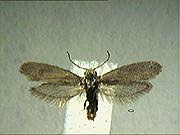Prodoxus cinereus
Olle PellmyrAdult Characteristics
Wing expanse 9-15 mm. Forewing uniformly pale to medium brown. Hindwings usually somewhat lighter, sparsely scaled.
Comparison with Similar Species
Prodoxus aenescens, which coexists with it, is very similar especially in the zone of overlap (where aenescens is lighter than farther north). They can be reliably told apart through inspection of the genitalia. In the male, the valva of cinereus is of about even width throughout and it has a relatively straight outer edge. In the female, the ovipositor has a modest, non-arched dorsal ridge that tapers off at the ovipositor shaft. The larva is distinctive because of two prominent ventral hooks on the tip of the abdomen. When the two species are found together, cinereus tends to emerge somewhat earlier than aenescens.
Host, Oviposition, and Larval Feeding Habits
The species occurs throughout the southern range of its exclusive host, Yucca whipplei (Agavaceae), basically coinciding with the monocarpic varieties of the host. It feeds primarily in the basal portion of the inflorescence stalk, and usually well below cinereus where they coexist.
Geographic Distribution
Known from a northern limit in the transverse ranges near Los Angeles south to the US-Mexico border.
References
Davis, D.R. 1967. A revision of the moths of the subfamily Prodoxinae (Lepidoptera: Incurvariidae). U.S. Nat. Hist. Mus., Bull. 255:1-170. Smiths. Contrib. Zool. 524:1-88.
Powell, J.A. and R.A. Mackie. 1966. Biological interrelationships of moths and Yucca whipplei. Univ. Calif. Publ. Entomol. 42:1-59.
Title Illustrations

| Scientific Name | Prodoxus cinereus |
|---|---|
| Location | Riverside Co., California, USA |
| Specimen Condition | Dead Specimen |
| Sex | Male |
| Image Use |
 This media file is licensed under the Creative Commons Attribution-NonCommercial License - Version 3.0. This media file is licensed under the Creative Commons Attribution-NonCommercial License - Version 3.0.
|
| Copyright |
© 1996

|
About This Page

University of Idaho, Moscow, Idaho, USA
Page copyright © 1996
 Page: Tree of Life
Prodoxus cinereus .
Authored by
Olle Pellmyr.
The TEXT of this page is licensed under the
Creative Commons Attribution-NonCommercial License - Version 3.0. Note that images and other media
featured on this page are each governed by their own license, and they may or may not be available
for reuse. Click on an image or a media link to access the media data window, which provides the
relevant licensing information. For the general terms and conditions of ToL material reuse and
redistribution, please see the Tree of Life Copyright
Policies.
Page: Tree of Life
Prodoxus cinereus .
Authored by
Olle Pellmyr.
The TEXT of this page is licensed under the
Creative Commons Attribution-NonCommercial License - Version 3.0. Note that images and other media
featured on this page are each governed by their own license, and they may or may not be available
for reuse. Click on an image or a media link to access the media data window, which provides the
relevant licensing information. For the general terms and conditions of ToL material reuse and
redistribution, please see the Tree of Life Copyright
Policies.
Citing this page:
Pellmyr, Olle. 1996. Prodoxus cinereus . Version 01 January 1996 (under construction). http://tolweb.org/Prodoxus_cinereus/12436/1996.01.01 in The Tree of Life Web Project, http://tolweb.org/








 Go to quick links
Go to quick search
Go to navigation for this section of the ToL site
Go to detailed links for the ToL site
Go to quick links
Go to quick search
Go to navigation for this section of the ToL site
Go to detailed links for the ToL site